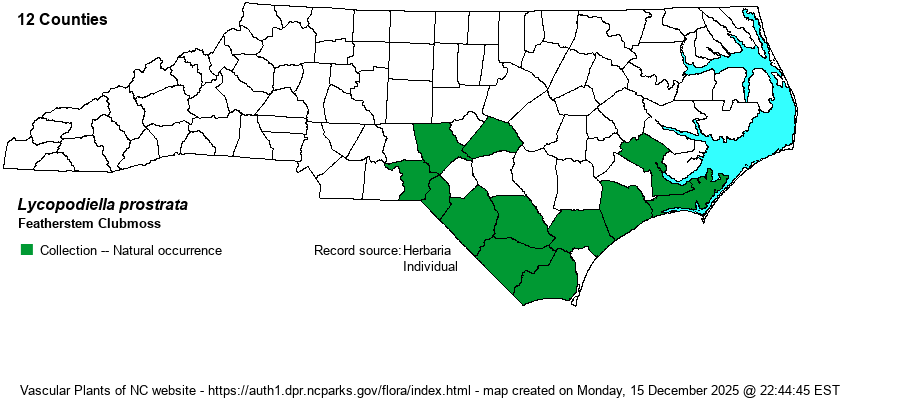| Author | (R.M. Harper) Cranfill | |
| Distribution | This species, formerly included within the old Lycopodium alopecuroides in most references, has been pulled out as a separate species, and thus could present some identification issues, especially to biologists unprepared to look for it. It ranges north only to the central portions of the Coastal Plain, being found primarily in the Sandhills and eastward, especially near or in Longleaf Pine communities.
This is primarily a Southern Coastal Plain species, ranging north to southern NC, and south to central FL, eastern TX, and AR. | |
| Abundance | Not well known, owing to similarity to L. alopecuroides. The NCNHP has it as a Watch List species and a State Rank of S2? It has been collected from at least 12 counties, and it is probably best called uncommon or infrequent, for the time being; a State Rank of S3? might be appropriate. | |
| Habitat | This species grows in similar or same habitats as does L. alopecuroides, which is little help in separating these two "cousins". It grows in savannas, wet flatwoods, ditches, seepages, damp sandy places, and other moist to wet acidic soils, generally in pinelands. | |
| Phenology | Fruits from July to September. | |
| Identification | This is a clubmoss of Coastal Plain pinelands, growing as a horizontal stem with scattered vertical ones. It has a stem which creeps along the ground, in contact with the ground for its whole length. The leaves of the sterile (horizontal) stem are dimorphic -- the upper ones are shorter than the lateral ones, and thus the stem is not equally "wide" or rounded, when the leaves are included, appearing flattened (wider than high); the erect stems are few in number, normally well away from the tip of the stem and unequal in height. Also, these lateral leaves tend to be more spreading than the more ascending leaves in L. alopecuroides, and thus the width of the stem (with leaves) averages 12-19 mm (about 2/3-inch) wide, as opposed to about 8-11 mm (2/5-inch) wide in L. alopecuroides. In this latter species, the sterile stem arches just over the ground (not completely touching it), to about 1-1.5 feet long, not rooting; it is covered on all sides by numerous ranks of linear to needle-like leaves, each about 1/4-inch long, generally at an acute angle to the stem. The vertical stems are the fertile ones, each growing erectly to about 4-6 inches high, with similar but slightly longer leaves covering the stem, and the strobili are at the ends of the branches, each about 1.5-2 inches long and single. Two other Coastal Plain clubmosses are similar, with linear stems/branches. L. appressa has the fertile leaves (on the vertical stems) rather short and appressed, and the strobili are narrow -- only about 3-6 mm versus 10-20 mm in these other two species. Pseudolycopodiella caroliniana, formerly in the same genus as these others, differs by the relatively few leaves on the vertical (fertile) stems, and these are whorled -- resulting in a very slender "stalk" that almost appears free of leaves; also, the leaves on the sterile (horizontal) stems are wider and occur as a flattened spray rather than the more rounded array of leaves in the others. | |
| Taxonomic Comments | Most older references had this taxon lumped into L. alopecuroides, often not even as a variety.
| |
| Other Common Name(s) | Prostrate Bog Clubmoss | |
| State Rank | S2? [S3?] | |
| Global Rank | G5 | |
| State Status | W7 | |
| US Status | | |
| USACE-agcp | OBL link |
| USACE-emp | OBL link |

